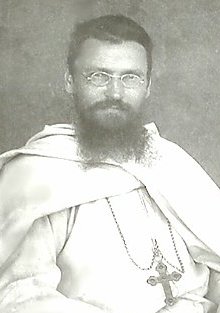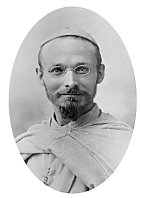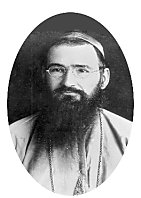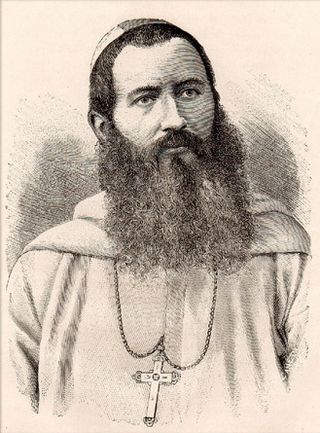Related Research Articles
The Apostolic Vicariate of Northern (Victoria) Nyanza was a Roman Catholic missionary jurisdiction in present Uganda.
The Vicariate Apostolic of Unyanyembe was an Apostolic vicariate located in German East Africa. It was promoted to the Diocese of Tabora in 1925 and to the Metropolitan Archdiocese of Tabora in 1953.

The Archdiocese of Kampala is the Metropolitan See for the Roman Catholic Ecclesiastical province of Kampala in Uganda.
The Roman Catholic Archdiocese of Mwanza is the Metropolitan See for the ecclesiastical province of Mwanza in Tanzania.
The Apostolic Vicariate of Kivu can refer to either of two vicariates of the White Fathers, a Catholic missionary society in the Latin Church of the Catholic Church. Both vicariates served lands around Lake Kivu during the early to mid 20th century. The first vicariate, from 1912 to 1922, served what are now Rwanda and Burundi. The second vicariate, from 1929 to 1952, served territory in the east of the Belgian Congo.
The Apostolic Vicariate of Tanganyika was a Catholic apostolic vicariate of the White Fathers missionary order at first centered on the mission of Karema in what is now Tanzania, that included parts of what are now Rwanda, Burundi, Democratic Republic of the Congo, Zambia and Malawi. As the number of missions, schools and converts grew, different regions became distinct vicariates covering portions of the original territory.
The Apostolic Vicariate of Southern Nyanza was a Roman Catholic mission territory in Eastern and Central Africa. It was an apostolic vicariate split out from the larger Vicariate of Nyanza in June 1894. It lost territory to the Apostolic Vicariate of Kivu in 1912, and was divided into the vicariates of Bukoba and Mwanza in 1929.

John Joseph Hirth was a Catholic bishop in German East Africa, known as the founder of the church in Rwanda.
Rubya is the site of a Catholic Church mission to the south of Bukoba near the west bank of Lake Victoria in Muleba District, Kagera Region, Tanzania. A seminary was established at Rubya in 1904, one of the first in German East Africa, as it then was. The seminary still operates. There is a cathedral, a nursing school and a district hospital, all operated by the church.
Joseph Francis Marie Sweens, was a Dutch Roman Catholic missionary bishop who served as the Vicar Apostolic of South Nyanza in German East Africa, later in the British-administered Tanganyika Territory, now Tanzania.
Kashozi is the site of a Catholic mission established in German East Africa, now Tanzania. It is about 16 kilometres (9.9 mi) to the north of Bukoba.

Léon-Antoine-Augustin-Siméon Livinhac, M.Afr. was a Catholic priest who established the church in what is modern Uganda and became head of the White Fathers. He oversaw a major expansion of the missionary society that coincided with the European colonial annexation of most of Africa.

Léon-Paul Classe, M.Afr. was a Catholic priest who was Vicar Apostolic of the Apostolic Vicariate of Ruanda, in what is now Rwanda, from 1922 until his death in 1945. During his time as a missionary priest and then bishop a great many Rwandans were converted to Christianity. Classe was influential in persuading the Belgian colonial administration to favor the Tutsis as a ruling caste in the country over the Hutu majority.
Laurent-François Déprimoz, M. Afr. was a Catholic priest who was Vicar Apostolic of the Apostolic Vicariate of Ruanda and then of the Apostolic Vicariate of Kabgayi.

Henri Streicher was a French Catholic missionary bishop who served as Vicar Apostolic of Northern Victoria Nyanza from 1897 to 1933. He ordained the continent's first Catholic priests of modern times, both from Uganda.

Antonin Guillermain was a Catholic missionary who was Vicar Apostolic of Northern Nyanza in what is now Uganda from January 1895 until his death in July 1896.

Buddu is a county (Ssaza) of the kingdom of Buganda in what is now Uganda.

Jean-Baptiste-Frézal Charbonnier, M.Afr. was a Catholic White Fathers missionary who was Vicar Apostolic of Tanganyika from January 1887 to March 1888.
Mathurin Guillemé was a Catholic White Fathers missionary who was Vicar Apostolic of Nyassa in today's Malawi from 1911 until his resignation in 1934.

Anatole-Joseph Toulotte was a French White Fathers missionary who was Vicar Apostolic of Sahara and Sudan from 1893 to 1897. Under his leadership the first White Fathers missions were established in the French Sudan (Mali) at Ségou and Timbuktu. A solitary, ascetic person, he was not a natural leader and drove himself too hard without regard for his health. He retired in 1897 due to physical and mental exhaustion after a long trip in West Africa. He is known as coauthor of a monumental history of Christian Africa in ancient times.
References
Citations
- ↑ Minnaert 2008, p. 188.
- ↑ Jeal 2011, pp. 419ff.
- ↑ Sundkler & Steed 2000, p. 594.
- ↑ Bukoba Catholic Diocese in Brief.
- ↑ Shorter 2003.
- ↑ Gadille 1994, p. 443.
Sources
- "Bukoba Catholic Diocese in Brief". Bukoba Catholic Diocese. Archived from the original on 2013-04-03. Retrieved 2013-03-30.
- Gadille, Jacques (1994). "GUILLERMAIN Antonin". In de Montclos, Xavier (ed.). Lyon, le Lyonnais, le Beaujolais. Dictionnaire du monde religieux dans la France contemporaine. Éditions Beauchesne. ISBN 978-2-7010-1305-3.
- Jeal, Tim (2011). Explorers of the Nile. Yale University Press. p. 419. ISBN 978-0-300-17827-2 . Retrieved 26 March 2013.
- Minnaert, Stefaan (1 April 2008). "Premier voyage de Mgr. Hirth au Rwanda...". Histoire et Missions Chrétiennes N-005. Acculturation, syncrétisme, métissage, créolisation (Amérique, Océanie. XVIe-XIXe s.). KARTHALA Editions. ISBN 978-2-8111-4265-0 . Retrieved 26 March 2013.
- Shorter, Aylward (2003). "Bishop Streicher, Henri 1863 to 1952". Dictionary of African Christian. Archived from the original on 2011-11-18. Retrieved 2013-03-26.
- Sundkler, Bengt G. M.; Steed, Christopher (2000). A History of the Church in Africa. Cambridge University Press. p. 597. ISBN 978-0-521-58342-8 . Retrieved 26 March 2013.